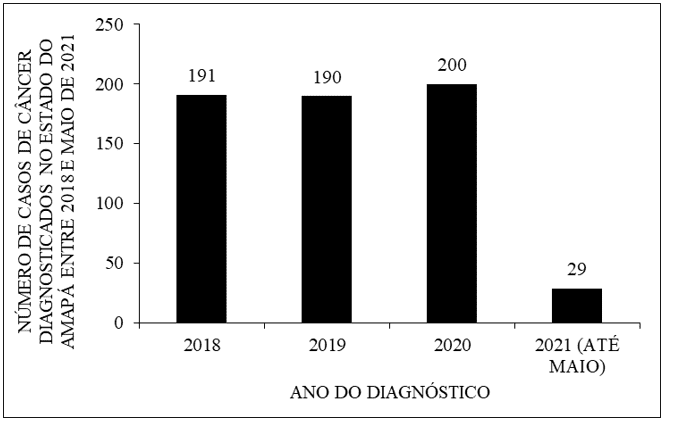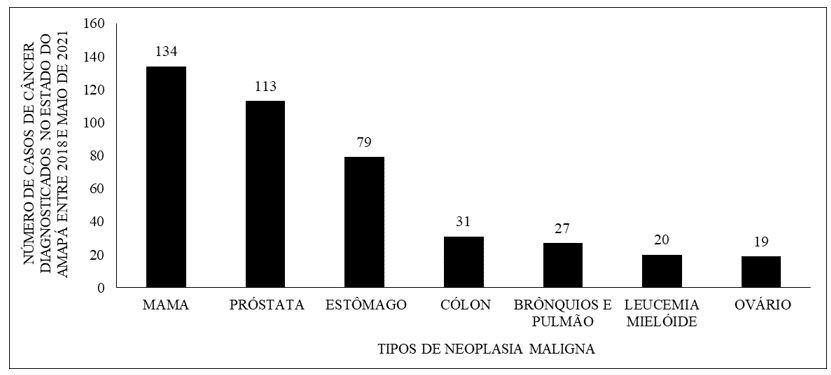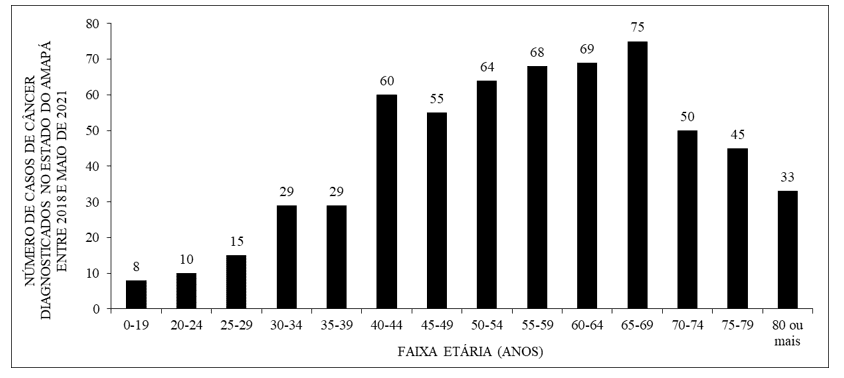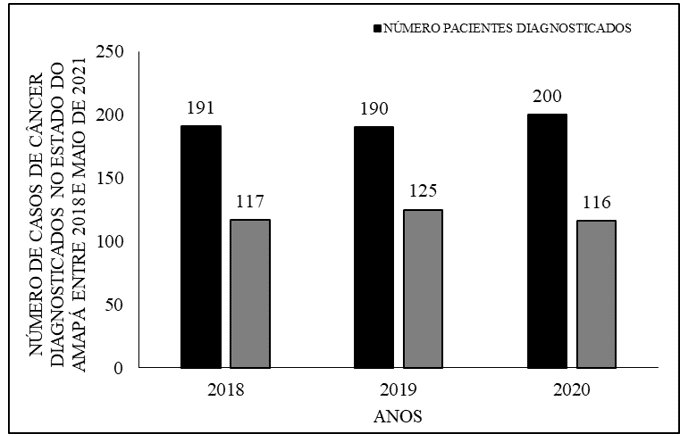ORIGINAL ARTICLE
TEIXEIRA, Isabelly Montenegro [1], LUCENA, Larissa Sena de [2], GIAMPIETRO, Zhandra Gramigna [3], SILVA, Rúbenns Tavares [4], ÁVILA, Gabriel Pereira [5], DIAS, Claudio Alberto Gellis de Mattos [6], DENDASCK, Carla Viana [7], OLIVEIRA, Euzébio de [8], FECURY, Amanda Alves [9]
TEIXEIRA, Isabelly Montenegro. et al. Epidemiological profile of cancer cases registered in a state in the northern region. Revista Científica Multidisciplinar Núcleo do Conhecimento. Year. 07, Ed. 11, Vol. 07, pp. 05-17. November 2022. ISSN: 2448-0959, Access link: https://www.nucleodoconhecimento.com.br/health/cancer-cases, DOI: 10.32749/nucleodoconhecimento.com.br/health/cancer-cases
ABSTRACT
Cancer encompasses a group of chronic pathologies with multifactorial causes and high levels of mortality in Brazil and worldwide. In addition, they constitute diseases with a great impact on the morbidity and mortality of patients and a high burden for the health system. Thus, the research seeks to outline the epidemiological profile of cancer in the state of Amapá from January 2018 to March 2021. For this, a descriptive, retrospective, cross-sectional study was used based on secondary public data from the “Panel Oncologia” , obtained from the Department of Informatics of the Unified Health System (DATASUS)[10]. A total of 610 cases were analyzed, of which 52.8% were male patients, with an emphasis on the age group of 65-69 years. Comparing the types of cancer, the most reported were breast (21.9%), prostate (18.5%) and stomach (12.9%). As for the establishment, the Hospital das Clínicas Doutor Alberto Lima (HCAL) was the health service that most diagnosed cases of malignant lesions in the state (90.3%) and the CRIO/CE unit was the location that received the highest number of cases patients treated outside the home (46.15%). It is concluded that cancer has a relevant prevalence in the population studied in the Amazon and knowledge of the epidemiological picture will enable better planning and disease control strategies and the prioritization of health promotion and prevention actions.
Keywords: Cancer, Epidemiology, Amapá.
INTRODUCTION
Cancer is the pathology that has the most impact in the clinical, social and economic context in relation to disability-adjusted life years (DALYs) among all human diseases (MATTIUZZI; LIPPI, 2019; FACCO et al., 2021) and is one of the leading causes of mortality worldwide (PANIS, et al., 2018; WHO, 2022), accounting for about 10 million deaths in 2020, excluding non-melanoma skin cancer (FERLAY, et al., 2021). In addition, according to economic development indicators, it is highlighted that the global burden of cancer is growing, relevant and uneven (GBD 2019, 2022; FARIAS et al., 2020) in age groups in places with more than five million inhabitants (ASSUNÇÃO ; FRANCE, 2020).
This disease is part of the group of Non-Communicable Chronic Diseases (NCDs) which has high morbidity and mortality in the population, burdens the health system, increases expenses with medical care and social security and directly affects people’s quality of life, may result from functional disabilities and one of the main causes of absence from work (ASSUNÇÃO; FRANÇA, 2020; MALTA et al., 2020; FIGUEIREDO; CECCON; FIGUEIREDO, 2021). In addition to neoplastic anomalies, NCDs include cardiovascular diseases, obstructive respiratory diseases, diabetes mellitus, cerebrovascular diseases (MALTA et al., 2017; MELO et al., 2019) among others (FACCO et al., 2021a).
In addition, cancer and associated factors are related to multifactorial causes associated with lifestyles and environmental and occupational exposures (INCA, 2022) and risk factors of prolonged course (FIGUEIREDO; CECCON; FIGUEIREDO, 2021) and that predispose the pathogenesis such as tobacco, sedentary lifestyle, harmful alcohol consumption, unhealthy eating habits (MALTA et al., 2017; ASSUNÇÃO; FRANÇA, 2020). It should be noted that these are conditions that can be modified, in addition to non-modifiable factors such as heredity, race and gender (MELO et al., 2019). It is noteworthy that these diseases affect individuals from various socioeconomic strata, notably those belonging to socially more vulnerable groups, such as those with lower educational levels and restricted income (MELO et al., 2019; MALTA et al., 2020).
In 2020, in South America, the main types of cancer related to sex, in terms of incidence and mortality, respectively, in the male population the incidence was prostate, lung, colon; and in terms of mortality, those of the lung, prostate and stomach dominated. In women, the most common neoplasms were breast, cervix and thyroid; and those that most caused death were breast, lung and cervix (FERLAY, et al., 2021).
In Brazil, this malignant lesion constitutes a relevant public health problem and is the second most frequent cause of death (INCA, 2022), with an estimate for each year of the 2020-2022 period of 625,000 new cases of cancer, with skin cancer non-melanoma the most frequent (177,000), followed by malignant breast and prostate tumors reaching 66,000 each, colorectal affecting 41,000 people, lung with 30,000 and stomach with 21,000 cases. Regarding geographic regions, the Southeast Region registers more than 60% of the incidence, followed by the Northeast (27.8%) and South (23.4%) Regions. It should be noted that the North of the country is the only location where the rates of breast and cervical cancer are equivalent among women. In view of this, there is a heterogeneity in terms of the magnitude and types of invasive neoplastic diseases between Brazilian regions (INCA, 2019).
According to the 2020-2022 estimates, the crude and adjusted rates of incidence per 100,000 inhabitants and the number of new cases of cancer, according to gender and primary location in Amapá are: 450/100,000 new cases for males with a prevalence of prostate, lung and stomach and in women the forecast is 410/100 thousand, predominantly cases of breast and cervical cancer (INCA, 2019).
Given the above, considering the scarcity of studies in areas of the Amazon, especially in Amapá, and the relevant prevalence of cancer in the general population, the present work points to the importance of notifying and monitoring this disease and its associated factors.
OBJECTIVE
This study aimed to outline the epidemiological profile of cancer in the State of Amapá from January 2018 to May 2021.
METHODOLOGY
A descriptive, retrospective, cross-sectional study was carried out through time until the start of cancer treatment – PAINEL ONCOLOGIA, a public domain tool, from the Department of Informatics of the Unified Health System – DATASUS, observing the following variables: number of cases per year, type of cancer, age group, sex, treatment establishment, number of cases per year of treatment according to year of diagnosis, in Amapá from January 2018 to May 2021. Data were collected, according to the following steps: The link http://tabnet.datasus.gov.br/cgi/dhdat.exe?PAINEL_ONCO/PAINEL_ONCOLOGIABR.def was accessed, from the opened page, the available periods 2018-2022 were selected, but in the data information was provided up to the month of May 2021. All data, in this and the next steps, were collected between the years 2018 to 2021, due to unavailability in the system until the date of data collection referring to the period after May 2021 On the line, gone if option “UF” of the diagnosis was taught: “Amapá”; and in the column each variable studied. The compilation of the data was done within the Excel application, a component of the Microsoft Corporation Office package.
RESULTS
Figure 1 shows that 610 cases of cancer were registered in the period, with the year 2020 having 200 cases, the highest number of diagnoses among the years analyzed. The year 2018 had 191 cases and 2019 had 190 records, showing a difference of a maximum of 10 cases from one year to the next among the first three years analyzed. The year 2021 was registered until the month of May in DATASUS, having registered 29 cases.
Figure 1 Shows the total number of cancer cases diagnosed in the state of Amapá, between 2018 and 2021

Figure 2 shows that among the 610 cases, 55 different types of cancer were diagnosed, with Breast Cancer being the most prevalent (21.9%); followed by prostate cancer (18.5%); Stomach Cancer (12.9%); Colon cancer (5.08%); Malignant Neoplasm of Bronchi and Lung (4.42%); Myeloid Leukemia (3.2%); Ovarian Cancer (3.1%) – which together represent 69.1% of registered cases, with the remaining 30.9% distributed among the other 48 types of cancer, with each type of the remaining percentage being less than 3% of the total cases.
Figure 2 Shows the total number of cancer cases diagnosed in the state of Amapá, between 2018 and 2021, by type of neoplasm

In figure 3, in relation to the variable age group of the analyzed patients, most cases were registered in patients aged between 65-69 years old (12.29%); and the lowest in those under the age of 19 (1.31%). A considerable growth of cases can be observed from the age group of 40 years old.
Figure 3 Shows the total number of cancer cases diagnosed in the state of Amapá, between 2018 and 2021, by patient age group

Chart 1 shows the gender of the analyzed patients, with males predominating over females, with a prevalence of 52.8% (322 cases) and 47.2% (288 cases), respectively.
Chart 1 Shows the total number of cancer cases diagnosed in the state of Amapá, between 2018 and 2021, by sex (gender)

There was variation according to the establishment of treatment, with Hospital das Clínicas Doutor Alberto Lima (HCAL) – Macapá/AP, the predominant location (90.3%); followed by the Integrated Regional Oncology Center (CRIO)[11] – Fortaleza/CE, which recorded 46.15% of cancer cases treated outside Amapá, that is, 6 out of 13 cases; and Hospital Ophir Loiola – Belém/PA, both accounting for approximately 1.5% of the records.
In 2018, of the 191 cases diagnosed, 117 (61.3%) received treatment in the year of diagnosis, 61 (31.9%) in 2019, 05 (2.6%) in 2020, and 02 (1.0 %) in 2021. In 2019, of the 190 diagnosed cases, 125 (65.8%) received treatment in the year of diagnosis, 52 (27.4%) in 2020, and 06 (3.2%) in 2021. In the year of 2020, of the 200 diagnosed cases, 116 (58.0%) received treatment in the year of diagnosis and 48 (24.0%) in 2021 (Figure 4).
Figure 4 Shows the total number of cancer cases diagnosed in the state of Amapá in 2018, and the number of patients who received treatment, per year

DISCUSSION
The study findings suggest that there was little difference in the number of cases diagnosed in the first three years of the study (2018, 2019 and 2020), except for 2021, which did not have complete data. With this, one can see a stability of cases over these years, which is consistent with the data presented by INCA, related to the incidence of new cases of cancer expected per year. For the year 2018, the institute estimated around 830 new cases, while for 2020, 870 records. Therefore, it is clear that there was only one discrepancy related to the number of these estimated cases and those that were diagnosed and reported (INCA, 2017; INCA, 2019).
With regard to the types of neoplasms, it is noted that the five most prevalent are: breast, prostate, stomach, colon and bronchi and lungs. In this regard, one can highlight the presence of stomach cancer as one of the most important in the State, which is in line with what is expected in general for Brazil, which, according to INCA, this type of cancer is found It is in the sixth place of the most prevalent, that is, it does not belong to the five most diagnosed. Still with regard to gastric CA (cancer), according to INCA, Amapá is the Brazilian state with the highest incidence of this disease among men (INCA, 2017; INCA, 2019). It is known that it is a neoplasm that arises from changes in the gastric mucosa, which may be related to some risk factors, such as certain dietary patterns – excess salt and low consumption of foods that contain vitamin C, for example -, infection by the bacterium Helicobacter pylori, chemical agents and others. With regard to infection by H. pylori, some data indicate that contamination occurs more frequently during childhood in populations of underdeveloped countries (BRITTO, 1997).
An important point to highlight is that the North Region of the country is the only one where breast and cervical cancer rates are equivalent among women (INCA, 2017; INCA, 2019). However, in this research, cervical cancer did not appear among the most prevalent, which may be related to the lack of specific analysis of the types of neoplasms between each gender. Cervical neoplasia is related to infection by the Human Papillomavirus (HPV) agent, thus being a disease that can be eradicated through vaccination. It is also subject to screening and early diagnosis through the Papanicolaou test. In this sense, it stands out as a characteristic disease of underdeveloped areas, due to the fact that the low socioeconomic status interferes with the population’s access to health and education services (BARBOSA et al., 2016).
When analyzing the age group variable, there is evidence of a continuous increase in cancer cases from the age of 45 to 69, when it begins to decline. As already explained, it is a disease classified within a group of Chronic Noncommunicable Diseases, with a large number of subtypes of neoplasms requiring a few years to develop. Thus, the risk of most cancers increases with age (INCA, 2011). In addition, one can relate, among other aspects, the decrease in the number of cases from the age of 69, with the life expectancy of the population of Amapa, which, according to the Brazilian Institute of Geography and Statistics (IBGE)[12], did not exceed 75 years in the studied period (BRASIL, 2020).
In epidemiological studies on cancer, it is already established that susceptibility to the disease is different between genders, being higher in males. The results of this research, despite the slight percentage difference, point to the same. This issue may be related to immunological differences between genders, such as the pattern of immune surveillance and genome surveillance mechanisms (DORAK, KARPUZOGLU, 2012).
For the treatment of the disease, there are several modalities, including: surgery, chemotherapy, radiotherapy, immunotherapy, bone marrow transplantation. In many cases, it may be necessary to associate more than one modality. However, two states of the federation do not have radiotherapy treatment, among them is the State of Amapá, which does not have availability of radiotherapy therapy either by the Unified Health System (SUS)[13], or by the private system. This means that, in many cases, treatment is carried out outside the home. It is estimated that around 60% of cases of malignant neoplasms will require radiotherapy treatment at some stage of the disease (FERRIGNO, 2013).
With regard to treatment, it was evident that, although most cases are treated in the State, a portion of patients still need to be referred to another location. In this regard, CRIO – Fortaleza/CE registered 46.15% of the cases of cancer treated outside Amapá, proving to be the main place for out-of-home treatment for the State in this period.
Treatment is one of the components of the national cancer control program. The effectiveness of the treatment is related to several variables, among them, the time that elapses between the diagnosis and the start of therapy (INCA, 2006). In the case of Amapá, during the period studied, it is clear that there was still a considerable percentage of cases that did not start treatment in the year of diagnosis or that there was no data on the subject, making it difficult to fully interpret the collected data. It is worth noting, however, that there is a law called the 60-day Law (12,732/12), in force since 2013, which guarantees cancer patients the right to start treatment against the disease, in the SUS, within a maximum of sixty days after diagnosis (BRASIL, 2012).
CONCLUSION
Based on the results obtained, it is concluded that among the cases of cancer notified in the DATASUS system from January 2018 to May 2021 (610 cases), in the State of Amapá there was a predominance of male patients aged between 65-69 years , the most common types of cancer were breast cancer (21.9%), prostate cancer (18.5%) and stomach cancer (12.9%) and the most prevalent health service was the Hospital das Clínicas Doutor Alberto Lima (HCAL) located in Macapá/AP that obtained 90.3% of the identified data and the CRIO health unit in Fortaleza/CE was the location that received the highest number of patients treated outside the home (46.15 %). It is worth mentioning that in the period from 2018 to 2020 there was a reduction in the identification of diagnoses and submission to appropriate treatment in the same year. Given the above, dietary patterns with excessive salt consumption and low vitamin C consumption, Helicobacter pylori and HPV infection, exposure to chemical agents, in addition to socioeconomic factors, such as poor access to health services, make it impossible to varied therapeutic strategies and makes out-of-home treatment a more viable option, interfering with the time between diagnosis and initiation of therapy. Thus, knowledge of the epidemiological situation will enable better planning and disease control strategies and the prioritization of actions to promote and prevent the health of the population. Finally, considering the scarcity of studies in poor urban areas of the Amazon, the failures in the coverage of the information system and the relevant prevalence of CNCD found, the present work points to the importance of monitoring these diseases and their associated factors.
REFERENCES
ASSUNÇÃO, Ada Ávila; FRANÇA, Elisabeth Barboza. Years of life lost by CNCD attributed to occupational hazards in Brazil: GBD 2016 study. Revista de saude publica. v. 54, n. 28. 2020. Disponível em: <https://www.ncbi.nlm.nih.gov/pmc/articles/PMC7069713/#fnb002>. Acesso em 01/05/2022.
BARBOSA, Isabelle Ribeiro et al. Desigualdades regionais na mortalidade por câncer de colo de útero no Brasil: tendências e projeções até o ano 2030. Ciência & Saúde Coletiva, [S.L.], v. 21, n. 1, p. 253-262, jan. 2016. FapUNIFESP (SciELO). http://dx.doi.org/10.1590/1413-81232015211.03662015. Disponível em: <https://www.scielo.br/j/csc/a/4fPmhjY8gB6pY8TsfKyBkjx/?lang=pt>. Acesso em 02/05/2022.
BRASIL. Constituição. Lei nº 12.732, de 2012. Lei Nº 12.732, de 22 de Novembro de 2012. Brasília, 22 nov. 2012. Disponível em: <http://www.planalto.gov.br/ccivil_03/_ato2011-2014/2012/lei/l12732.htm>. Acesso em 02/05/2022.
BRASIL. INSTITUTO BRASILEIRO DE GEOGRAFIA E ESTATÍSTICA (IBGE). Esperança de vida ao nascer. 2020. Disponível em: https://cidades.ibge.gov.br/brasil/ap/pesquisa/53/49645?ano=2020. Acesso em 30 abr. 2022.
BRITTO, Anna Valéria de. Câncer de estômago: fatores de risco. Cadernos de Saúde Pública, [S.L.], v. 13, n. 1, p. 7-13, 1997. FapUNIFESP (SciELO). http://dx.doi.org/10.1590/s0102-311×1997000500002. Disponível em: <https://www.scielo.br/j/csp/a/JxbpXSyDXZt7Gz5KTm8bYqs/?lang=pt>. Acesso em 02/05/2022.
DORAK, M. Tevfik; KARPUZOGLU, Ebru. Gender Differences in Cancer Susceptibility: an inadequately addressed issue. Frontiers In Genetics, [S.L.], v. 3, p. 1-11, nov. 2012. http://dx.doi.org/10.3389/fgene.2012.00268. Disponível em: <https://www.frontiersin.org/articles/10.3389/fgene.2012.00268/full>. Acesso em 02/05/2022.
FACCO, L., ALMENDRO, L.P., MARQUES, C.P., DIAS, C.A.G.M., OLIVEIRA, E., SOUZA, K.O., DENDASCK, C.V., ARAÚJO, M.H.M., FECURY, A.A. Neoplasia maligna de esôfago: uma análise epidemiológica dos casos notificados no Brasil entre 2015 e 2019. Research, Society and Development, v. 10, n.2, e57710212750, 2021 < https://rsdjournal.org/index.php/rsd/article/view/12750/11622>
FACCO, L., ALMENDRO, L.P., MARQUES, C.P., RIBEIRO, E.F.B., FECURY, A.A., DENDASCK, C.V., ARAÚJO, M.H.M., OLIVEIRA, E., DIAS, C.A.G.M. Neoplasia maligna de testículo: análise epidemiológica dos casos notificados no Brasil entre 2015 e 2019. Revista Científica Multidisciplinar Núcleo do Conhecimento. Ano. 06, Ed. 10, Vol. 07, pp. 62-74. Outubro de 2021 < https://www.nucleodoconhecimento.com.br/saude/neoplasia>.
FARIAS, RAFAELA SANTOS; FACCO, LUCAS; FECURY, AMANDA ALVES; ARAÚJO, MARIA HELENA MENDONÇA DE; OLIVEIRA, EUZÉBIO DE; DENDASCK, CARLA VIANA; SOUZA, KEULLE OLIVEIRA DA; DIAS, CLAUDIO ALBERTO GELLIS DE MATTOS. Casos confirmados de câncer no colo do útero no Brasil entre os anos de 2010 a 2014. Revista Científica Multidisciplinar Núcleo do Conhecimento, v. 25, p. 93-104, 2020 <https://www.nucleodoconhecimento.com.br/saude/colo-do-utero>
FERLAY, Jacques et al. Cancer statistics for the year 2020: An overview. Int J Cancer. 2021. Disponível em: <https://onlinelibrary.wiley.com/doi/10.1002/ijc.33588>. Acesso em 30/04/2022.
FERRIGNO, Robson. Panorama da Radioterapia no Brasil. 2013. Disponível em: <http://www.oncoguia.org.br/pub/15_oncoguia_noticias/Panorama_Radioterapia_Brasil.pdf>. Acesso em 30 abr. 2022.
FIGUEIREDO, Ana Elisa Bastos; CECCON, Roger Flores; FIGUEIREDO, José Henrique Cunha. Doenças crônicas não transmissíveis e suas implicações na vida de idosos dependentes. Ciência & Saúde Coletiva [online]. v. 26, n. 01, p. 77-88, 2021. Disponível em: <https://doi.org/10.1590/1413-81232020261.33882020>. Acesso em 01/05/2022.
GBD 2019. Global Burden of Disease 2019 Cancer Collaboration. Cancer Incidence, Mortality, Years of Life Lost, Years Lived With Disability, and Disability-Adjusted Life Years for 29 Cancer Groups From 2010 to 2019: A Systematic Analysis for the Global Burden of Disease Study 2019. JAMA Oncol. v.8, n.3, p. 420–444. 2022. Disponível em: <https://jamanetwork.com/journals/jamaoncology/fullarticle/2787350>. Acesso em 30/04/2022.
INCA. Instituto Nacional de Câncer José Alencar Gomes da Silva. ABC do câncer: abordagens básicas para o controle do câncer. Rio de Janeiro: INCA, 2011. 128 p. ISBN 978-85-7318-188-3 (versão eletrônica). Disponível em: <https://bvsms.saude.gov.br/bvs/publicacoes/inca/abc_do_cancer_2ed.pdf>. Acesso em 02/05/2022.
INCA. Instituto Nacional de Câncer José Alencar Gomes da Silva. A situação do câncer no Brasil. Rio de Janeiro: INCA, 2006. 120 p. ISBN 85-7318-121-4.
INCA. Instituto Nacional de Câncer José Alencar Gomes da Silva. Estimativa 2018: incidência de câncer no Brasil. Rio de Janeiro: INCA, 2017. 128 p. ISBN 978-85-7318-361-0 (versão eletrônica). Disponível em: < https://portaldeboaspraticas.iff.fiocruz.br/wp-content/uploads/2019/10/estimativa-incidencia-de-cancer-no-brasil-2018.pdf>. Acesso em 30/04/2022.
INCA. Instituto Nacional de Câncer José Alencar Gomes da Silva. Estimativa 2020: incidência de câncer no Brasil. Rio de Janeiro: INCA, 2019. 120 p. ISBN 978-85-7318-389-4 (versão eletrônica). Disponível em: < https://www.inca.gov.br/sites/ufu.sti.inca.local/files/media/document/estimativa-2020-incidencia-de-cancer-no-brasil.pdf>. Acesso em 30/04/2022.
INCA. Instituto Nacional de Câncer José Alencar Gomes da Silva. Gastos federais atuais e futuros com os cânceres atribuíveis aos fatores de risco relacionados à alimentação, nutrição e atividade física no Brasil. Rio de Janeiro: INCA, 2022. 50 p. ISBN 978-65-997716-0-6 (versão eletrônica). Disponível em: <https://www.inca.gov.br/sites/ufu.sti.inca.local/files//media/document/lo_inca_sumario-executivo_rev06-reduzido_0.pdf>. Acesso em 01/05/2022.
MALTA, Deborah Carvalho et al. Doenças crônicas não transmissíveis e a utilização de serviços de saúde: análise da Pesquisa Nacional de Saúde no Brasil. Rev Saude Publica. v.51 Supl 1:4s, 2017. Disponível em: <https://www.scielo.br/j/rsp/a/84CsHsNwMRNFXDHZ4NmrD9n/?lang=pt&format=pdf>. Acesso em 01/05/2022.
MALTA, Deborah Carvalho et al. Doenças Crônicas Não Transmissíveis na Revista Ciência & Saúde Coletiva: um estudo bibliométrico. Ciência & Saúde Coletiva [online], v. 25, n. 12, p. 4757-4769, 2020. Disponível em: <https://www.scielo.br/j/csc/a/nVqKXc5wPpsPNgTKc9fHBpt/?format=pdf&lang=pt>. Acesso em 01/05/2022.
MATTIUZZI, Camilla; LIPPI, Giuseppe. Current Cancer Epidemiology. Journal of epidemiology and global health. v. 9, n.4, p. 217-222, 2019. Disponível em: <https://www.ncbi.nlm.nih.gov/pmc/articles/PMC7310786/>. Acesso em 30/04/2022.
MELO, Silvia Pereira da Silva de Carvalho et al. Doenças crônicas não transmissíveis e fatores associados em adultos numa área urbana de pobreza do nordeste brasileiro. Ciência & Saúde Coletiva [online]. v. 24, n. 8, p. 3159-3168. 2019. Disponível em: <https://doi.org/10.1590/1413-81232018248.30742017>. Acesso em 01/05/2022.
PANIS, Carolina et al. Critical review of cancer mortality using hospital records and potential years of life lost. Einstein (São Paulo) [online]. v. 16, n. 1, eAO4018. 2018. Disponível em: <https://www.scielo.br/j/eins/a/vvfT8yR8KjTJjnptgwpFyBC/abstract/?lang=pt#>. Acesso em 30/04/2022.
World Health Organization (WHO). Cancer [Internet]. In: World Health Organization. 2022. Disponível em: <https://www.who.int/news-room/fact-sheets/detail/cancer>. Acesso em 30/04/2022.
APPENDIX – FOOTNOTE
10. Departamento de Informática do Sistema Único de Saúde (DATASUS).
11. Centro Regional Integrado de Oncologia (CRIO).
12. Instituto Brasileiro de Geografia e Estatística (IBGE).
13. Sistema Único de Saúde (SUS).
[1] Medical Student at the Universidade Federal do Amapá (UNIFAP).
[2] Medical Student at the Universidade Federal do Amapá (UNIFAP).
[3] Medical Student at the Universidade Federal do Amapá (UNIFAP).
[4] Medical Student at the Universidade Federal do Amapá (UNIFAP).
[5] Medical Student at the Universidade Federal do Amapá (UNIFAP).
[6] Biologist, PhD in Theory and Research of Behavior, Professor and researcher at the Instituto de Ensino Básico, Técnico e Tecnológico do Amapá (IFAP), the Programa de Pós Graduação em Educação Profissional e Tecnológica (PROFEPT IFAP) and the Programa de Pós Graduação em Biodiversidade e Biotecnologia da Rede BIONORTE (PPG-BIONORTE), Amapá hub.
[7] PhD in Psychology and Clinical Psychoanalysis. Ongoing PhD in Communication and Semiotics at the Pontifícia Universidade Católica de São Paulo (PUC/SP). Master’s Degree in Religious Sciences from Universidade Presbiteriana Mackenzie. Master in Clinical Psychoanalysis. Degree in Biological Sciences. Degree in Theology. He has been working with Scientific Methodology (Research Method) for more than 15 years in the Scientific Production Guidance of Master’s and Doctoral Students. Specialist in Market Research and Health Research. ORCID: 0000-0003-2952-4337.
[8] Biologist, PhD in Tropical Diseases, Professor and researcher of the Physical Education Course, Universidade Federal do Pará (UFPA).
[9] Biomedical, PhD in Tropical Diseases, Professor and researcher at the Campus Macapá Medicine Course, Universidade Federal do Amapá (UNIFAP), and at the Programa de Pós-graduação em Ciências da Saúde (PPGCS UNIFAP), Pro-Rector of Research and Postgraduate Graduation (PROPESPG) from the Universidade Federal do Amapá (UNIFAP).
Submitted: November, 2022.
Approved: November, 2022.















